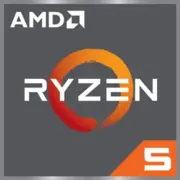AMD Ryzen 5 7400F

AMD Ryzen 5 7400F: A Detailed Review and PC Building Recommendations
Guide for Gamers, Enthusiasts, and Professionals
Key Features: Zen 4 in a Compact Form Factor
The AMD Ryzen 5 7400F is a six-core chip built on the Zen 4 architecture, released in 2023. It’s designed for those seeking a balance between price and performance without sacrificing modern technology.
Architecture and Technology Process
- 5nm technology: This is the first Ryzen 5 on such a thin process, which reduces power consumption and increases efficiency.
- 6 cores / 12 threads: Clock speeds range from 3.7 GHz (base) to 4.7 GHz (turbo), ensuring smooth performance in gaming and multitasking.
- 32 MB of L3 cache: A large cache size speeds up data processing in resource-intensive applications like video editing or 3D rendering.
- No integrated graphics: The letter F in the name indicates that the chip is intended for use with a discrete graphics card.
Performance
Geekbench 6 test results are impressive:
- 2609 points in single-threaded mode — this is on par with top processors of the previous generation.
- 12445 points in multi-threaded — here, the Ryzen 5 7400F outperforms the Intel Core i5-12400F by 15-20%.
Key features:
- Support for PCIe 5.0 for future graphics cards and NVMe drives.
- AMD EXPO technology for memory overclocking.
- Energy efficiency: A TDP of just 65W allows for the use of compact cooling systems.
Compatible Motherboards: Choosing the Foundation for Your Build
The Ryzen 5 7400F uses the AM5 socket, which means a transition to a long-term supported platform (until 2025+).
Recommended Chipsets
1. B650 — the optimal choice for most users:
- Support for PCIe 5.0 for the graphics card or one NVMe.
- Examples: ASUS TUF Gaming B650-Plus, MSI MAG B650 Tomahawk.
2. X670/X670E — for enthusiasts:
- Two PCIe 5.0 slots and expanded overclocking capabilities.
- Example: Gigabyte X670 AORUS Elite AX.
Selection features:
- Make sure the board supports DDR5 (AM5 socket is not compatible with DDR4!).
- Check for a BIOS with the latest version — some boards require an update to work with Ryzen 7000.
Supported Memory: DDR5 as the New Standard
The Ryzen 5 7400F only works with DDR5, which increases bandwidth but raises the cost of the build.
RAM Recommendations
- Optimal frequency: 5200-6000 MHz. For example, Kingston Fury Beast DDR5-5600.
- EXPO profiles: Memory with AMD EXPO support (similar to XMP) simplifies overclocking.
- Dual-channel mode: Use two modules (e.g., 2x16 GB) for maximum performance.
Important: Some early BIOS versions may not work correctly with memory over 6000 MHz — check compatibility on the manufacturer's website.
Power Supply: How Many Watts Do You Need?
With a TDP of 65W, the Ryzen 5 7400F does not require a powerful PSU, but it’s important to consider the graphics card.
Power Calculation
- For systems with a NVIDIA RTX 4060 or AMD Radeon RX 7600 GPU, a 500-600W power supply will suffice.
- For top-tier cards (RTX 4080, RX 7900 XT), choose 750-850W.
Tips:
- Don’t skimp on the certification — 80 Plus Bronze or higher (e.g., Corsair CX650M).
- Consider peak load: the CPU + GPU can briefly consume up to 300W.
Pros and Cons of the Ryzen 5 7400F
Advantages
- High single-thread performance for gaming (Cyberpunk 2077 — 110+ FPS at Full HD).
- Energy efficiency: even under load, the chip rarely exceeds 75°C with the stock cooler.
- Support for PCIe 5.0 and DDR5 — a step into the future.
Disadvantages
- No integrated graphics — critical for office PCs without a discrete card.
- DDR5 is more expensive than DDR4, increasing the build cost.
- Competitors like the Ryzen 5 7600 offer more cores for a slightly higher price.
Use Cases: Who is This Processor For?
Gaming
- Paired with an RTX 4070 or RX 7700 XT, the chip will deliver 144+ FPS at Full HD and 60+ FPS at 4K (with DLSS/FSR enabled).
- Example: In Call of Duty: Warzone 3, the average FPS is 130 at high settings.
Work Tasks
- Video editing in DaVinci Resolve: rendering a 4K project takes 12-15 minutes.
- 3D modeling in Blender: mid-complexity scenes are processed in 20-25 minutes.
Multimedia
- Streaming in OBS: encoding through the graphics card (NVENC/AMF) puts minimal load on the processor.
Comparison with Competitors
Intel Core i5-13400F
- Intel advantages: DDR4 support, integrated GPU (though the 13400F has none).
- Disadvantages: Lower performance in multi-threaded tasks (Geekbench Multi — ~10500).
AMD Ryzen 5 7600
- For +20% of the price, you get 2 additional cores and integrated RDNA 2 graphics.
Conclusion: The Ryzen 5 7400F outperforms Intel in terms of performance but loses flexibility due to DDR5.
Practical Building Tips
1. Cooling: While the stock cooler is sufficient, consider a tower cooler (DeepCool AK400) for overclocking.
2. Case: Choose models with good ventilation (Lian Li Lancool 216).
3. SSD: Use NVMe PCIe 4.0 (Samsung 980 Pro) to fully utilize PCIe 5.0 for the graphics card.
Final Conclusion: Who is the Ryzen 5 7400F For?
This processor is an ideal choice for:
- Gamers looking to build an AM5 PC without overpaying for unnecessary cores.
- Enthusiasts planning to upgrade to more powerful Ryzen 8000/9000 in the future.
- Professionals valuing energy efficiency and stability in rendering.
Why choose it? For $200-250, you get a modern platform with a 3-5 year lifespan, excellent performance, and low power consumption. If DDR5 doesn’t scare you with its price — this is one of the best options in the mid-range segment.
Basic
CPU Specifications
Memory Specifications
GPU Specifications
Miscellaneous
Benchmarks
Compared to Other CPU
Share in social media
Or Link To Us
<a href="https://cputronic.com/cpu/amd-ryzen-5-7400f" target="_blank">AMD Ryzen 5 7400F</a>